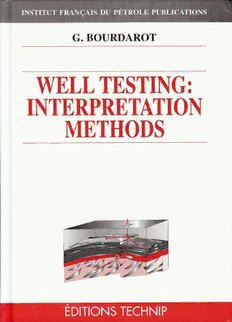
Well Testing: Interpretation Methods (Institut Francais Du Petrole Publications) PDF
342 Pages·1999·11.467 MB·English
Most books are stored in the elastic cloud where traffic is expensive. For this reason, we have a limit on daily download.
Preview Well Testing: Interpretation Methods (Institut Francais Du Petrole Publications)
Description:
This book is designed to be a technical reference for engineers and technicians who interpret well tests. For each case examined, it describes the most suitable interpretation methods, such as traditional methods, type curves, computer-generated type curves, and interpretation using derivatives. It cites the equations used to interpret results, while avoiding detailed mathematical discussions. Nevertheless, as numerous references are provided, those who wish to can trace the solutions back to their origins. The book also indicates the conditions under which different methods are useful, and is illustrated with a large number of figures and practical examples. The text shows how the interpretation of a well test varies according to the type of reservoir limits (e.g., faults, channels, secant faults, constant pressure limits, closed reservoir, etc.), the well reservoir configuration (e.g., partial penetration wells, inclined wells, artificially fractured wells, horizontal wells, injection wells, etc.), and the nature of more complex reservoirs (fissured reservoirs, two-layered reservoirs). It indicates which methods to use when the fluid in a well is a gas or a polyphasic fluid. Lastly, it deals with tests applied to multiple wells, including interference tests and pulse tests.Contents: Principle: 1. Principles of well testing. 2. Wellbore storage. 3. Skin. Interpretation methods: 4. Conventional interpretation methods. 5. Type curves. 6. The derivative. Reservoir boundaries: 7. Linear sealing faults. 8. Channels. 9. Intersecting faults. 10. Constant pressure boundary. 11. Closed reservoir. 12. Productivity index. Reservoir aspects: 13. Naturally fractured reservoirs. 14. Two-layer reservoirs. Well aspects: 15. Partial penetration wells. 16. Slanted wells. 17. Artificially fractured wells. 18. Horizontal wells. 19. Injection wells. Fluid aspects: 20. Gas wells. 21. Multiphase flows. Interferences : 22. Interference tests. 23. Pulse tests. Bibliography. Index.
See more
The list of books you might like
Most books are stored in the elastic cloud where traffic is expensive. For this reason, we have a limit on daily download.
